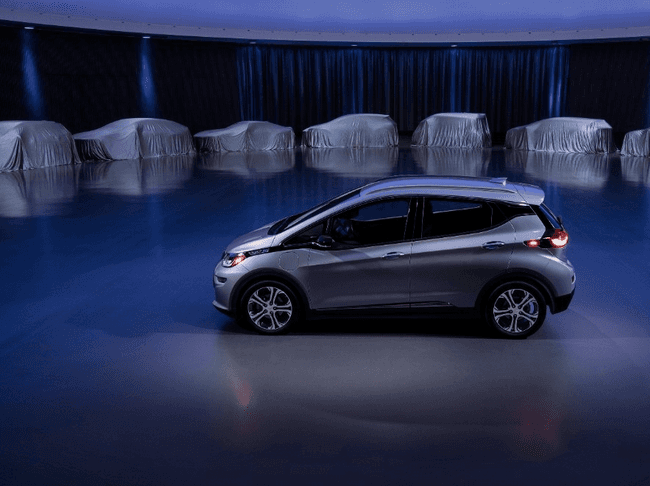
GM sent a ripple across the web on Monday with the attention-grabbing announcement of its "path to zero emissions" plan, which includes an impressive lineup of at least 20 electric vehicles by 2023. To the casual observer, that means a head-on collision with Tesla, but GM adds an interesting twist. Instead of only offering battery-powered EVs, GM will include a healthy dose of EVs that run on hydrogen fuel cells.
That's a surprise move considering the intensive criticism that hydrogen fuel cell vehicles have endured, so let's take a look under the hood and see what's going on.
GM's big EV announcement...
GM's announcement was pretty thin on details, but it looks like the company is convinced that the all-EV future is immanent. Here's the explainer from Mark Reuss, General Motors executive vice president of Product Development, Purchasing and Supply Chain:
General Motors believes in an all-electric future. Although that future won't happen overnight, GM is committed to driving increased usage and acceptance of electric vehicles through no-compromise solutions that meet our customers' needs.
The news is not exactly a bolt out of the blue, so to speak. Though GM's first foray into the EV market was a flop -- it introduced the ill-fated EV1 all the way back in 1996 -- in recent years the company began changing hearts and minds with its gas-electric hybrid Chevy Volt, and followed that up with the highly regarded all-electric Chevy Bolt.
The Volt seems to be taking a back seat when it comes to the EV of the future. The Volt has a gasoline tank to cushion drivers against battery range anxiety, and drivers seem to be responding nicely to the mix (a gas-powered generator kicks on when the battery runs out, so the car always runs on electric drive no matter what). However, GM is convinced that all-electric cars are the wave of the future:
In the next 18 months, GM will introduce two new all-electric vehicles based off learnings from the Chevrolet Bolt EV. They will be the first of at least 20 new all-electric vehicles that will launch by 2023.
...is all about hydrogen fuel cell vehicles
So, here's where things get interesting. Like practically every other major car maker except Tesla, GM has been tinkering around with hydrogen fuel cell vehicles.
Hydrogen FCEVs run on electric drive, just like the more familiar battery-powered EVs. The basic difference is that batteries need to be charged up, while fuel cells generate electricity on-the-go.
GM is no newcomer to fuel cell technology. The company first introduced an "Electrovan" hydrogen fuel cell demonstration vehicle in 1966. The concept went into the deep freeze for a while but roared back into life in 2013, when GM and Honda announced a fuel cell collaboration. In 2016 GM dropped another strong hint that it was planning on a fuel cell future, and earlier this year GM and Honda announced they would partner in a new $85 million fuel cell plant in Michigan.
Meanwhile, GM has been working with the U.S. Army on bringing fuel cell technology to the Defense Department's vehicular fleet. In 2012 GM helped the U.S. Army establish its first hydrogen fuel cell EV fleet, and the company is also developing the ZH2 tactical fuel cell EV for the Army.
This is all happening despite persistent criticism from Telsa co-founder Elon Musk, who has famously referred to fuel cell technology with a curse.
GM's new EV announcement blithley steps over that remark:
GM also introduced SURUS — the Silent Utility Rover Universal Superstructure — a fuel cell powered, four-wheel steer concept vehicle on a heavy-duty truck frame that’s driven by two electric motors. With its capability and flexible architecture, SURUS could be used as a delivery vehicle, truck or even an ambulance — all emissions free.
If you caught that thing about trucks, you're on to something. Though EV battery technology is improving and will continue to improve, GM is among the carmakers looking to fuel cells for powering SUVs as well as medium and heavy-duty vehicles.
But what about the hydrogen?
The missing piece in all this is a sustainable fuel supply chain. Like their battery EV cousins, hydrogen fuel cell EVs have zero emissions at the tailpipe. That's all well and good, but if you're charging up your battery from a grid that includes coal and natural gas -- or if the hydrogen for your fuel cell is sourced from natural gas -- then your EV is not as sustainable as it could be.
The picture is rapidly changing for battery EVs. Coal is toast, renewables are beginning to edge natural gas out of the grid, and battery EV owners have the potential to source their own electricity from rooftop solar arrays.
Renewable options are also beginning to emerge for hydrogen with the advent of biogas as a source instead of fossil natural gas. "Water-splitting" technology powered by solar or wind energy is also paving the way for sustainable hydrogen fuel.
GM is looking ahead to a more sustainable manufacturing model, too. The company recently announced a big wind energy buy for electricity to power its factories in Ohio and Indiana.
Image (screenshot): via GM.

Tina writes frequently for TriplePundit and other websites, with a focus on military, government and corporate sustainability, clean tech research and emerging energy technologies. She is a former Deputy Director of Public Affairs of the New York City Department of Environmental Protection, and author of books and articles on recycling and other conservation themes.














